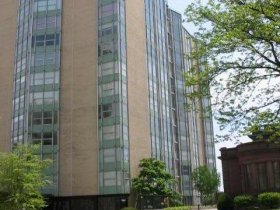Vel Phillips’ Newport Co-op
The high-rise co-op has "sweeping" views of Lake Michigan and Shepherd publisher Lou Fortis as a fellow resident. What more could you ask for?
This 15-story 1961 highrise was designed by Russell Barr Williamson (1893-1963) for the Newport Corporation, a cooperative housing association founded in 1958 for the purpose of constructing and owning this 81 unit building. An upper floor unit is occupied by Vel Phillips, a civil rights and woman’s rights pioneer who turned 90 on February 18th, 2014.
Cooperative housing is a rare form of home ownership in Milwaukee, with only the Newport and nearby 9-unit 1889 Ogden Row as examples. Unlike condominium ownership, in which one takes title to his or her unit, co-ops operate on a corporate model — you buy a share in the business, (in this case the Newport Corporation) which then leases you a unit. Unlike condos, where each unit gets its own tax bill, there is only one tax bill sent to the co-op and that is for the total value of the property. The taxes are then apportioned to each unit as part of the monthly maintenance fee.
Co-ops are run by a board of directors, not an owners association, and new purchasers must be approved by the board. Rules are often stricter for co-ops than condos, and the co-op interview process is not for everybody. Count Richard Nixon and Gloria Vanderbilt among those who could not make the cut in New York, where co-ops are common. Co-ops are often more difficult to finance than condos, since owners do not receive title to the property. As a result, creative financing — or cash sales — are often employed. On the plus side, co-ops tend to be cheaper than condos, and that appears to be the case at the Newport.
The cooperative movement reached its zenith in America in postwar New York City, with even the Communists getting into the housing business. Many co-ops were built as affordable housing, often for union workers, while some co-ops are decidedly upper-crust affairs. Today, in New York, co-ops constitute about 75 percent of the multifamily home purchase market, with only 25 percent condos. However, most new developments are condo, not co-op, so that ratio is changing.
The board approval process for co-ops was used in some circumstances to keep Jews and other minorities out of some luxury buildings. On the other hand, some co-ops were organized by Jews to give them an opportunity to build their own luxury buildings.
The street had gone into decline over the first decades of the 20th century as the automobile opened up new housing districts like Fox Point and River Hills, where many of the old-line Milwaukee families like the Van Dykes and Cudahys had fled. As early as 1932 a headline read, “First Families Desert Old Mansions of Prospect Ave.”
The Newport was to be a remedy for that decline. An advertisement for the building in 1960 exulted: “this could be the advance wave of wealth and talent returning to the city.” The ad was prescient, if a tad early, as the city’s renaissance came in the 1990s, with many suburbanites moving to downtown condos.
The ad said units would be available for between $41,500 and $70,000 with an annual maintenance fee ranging from $3,299 to $5,574. Part of that fee was tax-deductible, as it represented the property tax payment for each unit, as it does today.
In a 1960 Milwaukee Sentinel story that was gassy even for its time, the Newport Company bragged, “even the legendary magnificence of old emperors pales before the splendor of the Newport’s quality.” After all, the Newport boasted marble and granite from Italy, Norway, Africa, Vermont and Virginia, wall hangings of silk, and custom carpeting. Each unit had a Westinghouse electric range, electric dishwasher and electric bathroom heater, just like the Beverly Hillbillies had. All of these Westinghouse servants provided for the “ultimate in carefree in-town living with the city’s most dramatic views of the Lake. … Electric living — with these ultra-modern appliances.” (Some of these ultra-modern appliances are still in place in some units.)
Today’s marketing focus is on the rooftop deck, the terrace, the internet, uniformed doormen and car washing service downstairs in the heated garage. The building is run by a superintendent, engineer, office manager, full-time custodian and that board of directors. Somebody from these ranks will deliver the daily newspaper to your front door. All guests must be announced.
Most of the units are around 1700 square feet and include two bedrooms and two baths. “Every apartment has a sweeping view of Lake Michigan and the City. There are no blind spots, no second-rate views,” we learn. The Sentinel reporter said this was due to Williamson’s innovative “Quartic T” design, although the term (which the reporter, we suspect, made up) did not catch on.
Units are occasionally available at the Newport. Unit 1404 is available for $139,900, with $1,368 monthly service fees (including tax). Unit 1206 can be yours for $229,900 with $1,691 in monthly fees. Its tax bill portion is $5,481 per year. Unit 106, a unique 3-bedroom unit with adjacent garden terrace and Koi pond was the home for many years of Ben Barkin, who handled PR for Schlitz Brewery and who gave us the Great Circus Parade. It is available for $550,000 and will cost you $2,176 a month in fees and taxes.
In addition to Ms. Phillips, your neighbors include former Urban Milwaukee City Person Frances Ullenberg, arts patron and curator Jane Brite, former Summerfest chair Howard Schnoll, attorney Joseph Schoendorf and Louis Fortis, publisher of the Shepherd Express. For a number of months recently the Shepherd Express had a half-page full-color advertisement offering a Newport unit for rent. This quite possibly is owned by Fortis, whose residence is listed as unit 1102. Who else would have spent so much money on that ad?
None of the residents appear to be young — this is not a family building, and no pets are allowed. Nor is Vel Phillips, at 90, the oldest person to have resided there. Former resident David Rellin, the founder of Peacock Shoe Store, was 102 when he died in 2002, so Vel has something to look forward to.
The Rundown
- Location: City of Milwaukee
- Neighborhood: Lower East Side
- Subdivision: Rogers’ Addition
- Year Built: 1961
- Style: Highrise
- Size about 1,700 square fee per unit on average
- Taxes: $399,460.46 for the whole building, or about $5,000 per unit.
- Assessment: Land $901,500 [$25 s.f.], Improvements $12,382,200; Total: $13,283,700.The average unit is valued at about $164,000.
- Walk Score: 92 out of 100, “Walker’s Paradise”
- Street Smart Walk Score: 85 out of 100 “Very Walkable” The location is penalized due to a lack of intersections. However, there is no need for numerous intersections, since the site is on the edge of a lake.
- Transit Score: 52 out of 100, “Good Transit.” The location is penalized because it is at the edge of the city. No reason for eastbound buses here.
How Milwaukee Is It? The residence is about 1.3 miles from Vel’s old office in City Hall via the Lakefront.
About Vel Phillips
In 1951 Vel Rodgers Phillips, a Milwaukee native, was the first African-American woman to earn a law degree from the University of Wisconsin-Madison. She and her husband, W. Dale Phillips, whom she married in 1947, became the first husband-and-wife team admitted to the Federal Bar in Milwaukee. He died in 1988. In 1953 she ran unsuccessfully for the school board here, but achieved her first electoral victory in 1956 when she became the first female and the first African-American elected to the Milwaukee Common Council. She served on the council for 15 years, and was the voice of conscience on civil rights and open housing, which were major issues in the 1960s.
In 1958 Phillips was the first African-American national committeewoman for the Democratic Party of Wisconsin, and was later the first African-American woman to serve on the National Committee of any party. In 1971, Governor Patrick Lucey, who now lives further up N. Prospect Ave. in the Catholic Home, appointed her to a vacant seat on the Children’s court in Milwaukee County, and she became the state’s first African-American judge. She lost the subsequent election. In 1978 she was elected Secretary of State of Wisconsin, but lost in the 1983 primary to Douglas LaFollette,who remains in office. Vel Phillips remains the only African-American elected to statewide office. In addition, she has won many awards and honorary degrees.
In 2006, she established the Vel Phillips Foundation. However, the IRS has suspended the tax-exempt status of the foundation for failure to file tax returns for three consecutive years.You can still make a donation, if you would like.
Fun Fact: W. Dale Phillips and Vel Phillips are still listed as the owners of a $144,800 single family 1876 home on N. Booth St. that they bought in the 1960s from then-Mayor Henry Maier.
House Confidential Database
| Name | City | Assessment | Walk Score | Year |
|---|---|---|---|---|
| Name | City | Assessment | Walk Score | Year |


















Isn’t there still the “Hippy” co-op in Riverwest? Just East of Humboldt and South of the Baseball field? across from Collectivo. I don’t know if it’s the same structure as the Newport but It’s been around for a long time.
I’m relatively familiar with this building, as I lived for a couple of years at Prospect Towers, only a building or two north of this one and completed a few years later in 1964. Fantastic location, but those monthly fees, roughly equivalent to a typical monthly mortgage payment (or more), have always discouraged ownership for those who lack the financial wherewithal to buy a unit outright. It’s easy to see why there are so many more co-ops in New York because of the relatively enormous number of very wealthy folks there.
The article omited a major difference between co-ops and condos (which often explains co-ops’ higher monthly fees).
A condo owner can take out a mortgage on his unit, but the condo board itself usually cannot borrow at all. The situation is reversed with a co-op; a co-op owner cannot take out a mortgage (although he can take out a similar “co-op loan”), but the building itself can take out a mortgage (and often does).
When existing rental buildings are prepared for conversion to co-ops, the sponsor often takes out a large mortgage to fix things up prior to sale. Any money left over goes right into the sponsor’s pocket–part of his profit from selling the building. The money (over and above what is needed for pre-sale fix-ups) goes to the seller and is eventually repaid by the buyers. This allows the sale price to be reduced but increases the monthly fees.
And it’s not just buildings that recently became co-ops. Many co-ops take out additional mortgages over time to finance maintenance (or just to refinance the original mortgage). In the NY City area (which has lots of co-ops), co-ops usually have much lower selling prices (but higher monthly fees) than similar condos because, when you buy a co-op apartment, that unit is usually already mortgaged.